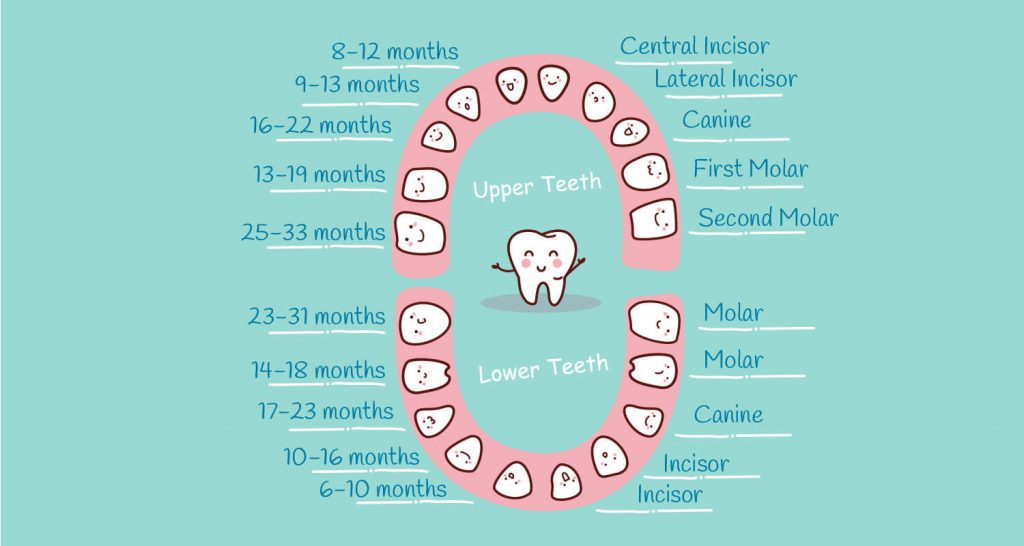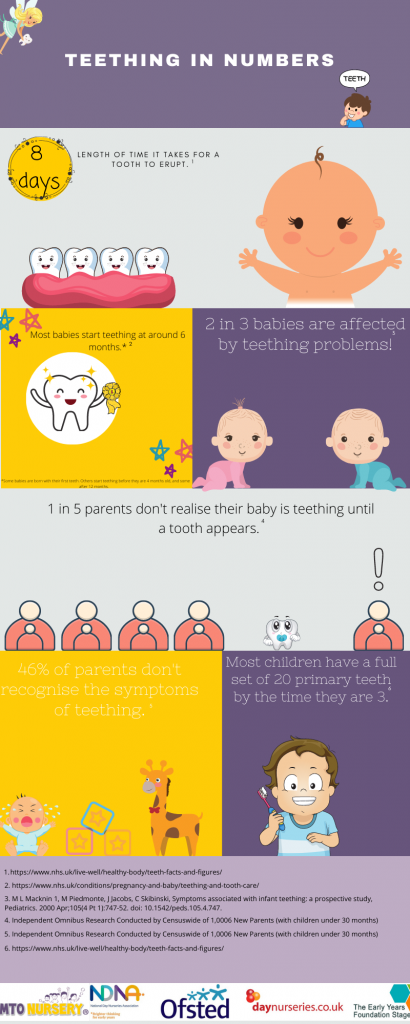[cmsmasters_row][cmsmasters_column data_width=”1/1″][cmsmasters_text]
Teething can be a frustrating time for carers, and although it’s inevitable in the baby’s development, most parents wish the time away. After all, who wants to see their baby in pain? Getting through this stage can be painful for the child and worrying for the parents.
It’s important to mention that some babies show no signs of teething, and some will suffer for many months. Nonetheless, if you know what signs and symptoms to look out for, you can alleviate the discomfort without a professional’s help.
When do babies get teeth?
In some instances, the baby can be born with a tooth or two. Nonetheless, although the time frame isn’t a rule, you will be able to notice your baby’s first teeth between 6 to 12 months old. However, by the time the child reaches 3-years old, they should have a full set of teeth.
You will notice that around three months of age, your baby will begin to discover the environment around them by increasingly putting toys and their hands in their mouth. Usually, the first teeth will appear in pairs or one after the other within a short time. Most commonly, the first teeth are the two bottom front teeth.
Take a look at the chart below:

Without a doubt, baby teething is a stage in their development that sneaks up on you unexpectedly. The symptoms can appear before you even think to look for changes in the child’s mouth. Thus, it’s essential to familiarise yourself with the typical symptoms and signs.
So, what are the symptoms?
Biting and Gnawing
Your baby will begin to bite on anything that they can see, including spoons, toys, and fingers. Even though they’ve only been around for a few months, they figure out that chewing is a pain reliever. As their gums are irritated, the counter pressure from biting will relieve some of their gums’ discomfort. So, as the tooth is pushing up, the item they bite will push down on the tooth, hence, relieving the painful pressure.
How to help: It can be challenging to allow your child to bite on everything that comes into sight. However, if it’s safe and hygienic, you shouldn’t worry. The best option is to purchase baby teether toys.
Drooling
Sometimes it can be too sticky, slimy, and unpleasant when it gets on clothes, furniture, and you. Fortunately, though, increased drooling is a good sign when it comes to a baby teething. Think of all of the baby’s things in their mouth; sometimes, it can be doorknobs, dirty toys, and unsensitised items. The drool is similar to a protective barrier as it’s like a cushion for the gums.
Defendant Drool, to the rescue!
Additionally, the antibodies in the drool will protect gums from potential infections. Regardless of how vigilant you are, your baby will find something weird to put in their mouth.
To remember: There are several reasons why babies experience excess drooling. If the baby isn’t showing the other signs of teething, you should seek a professional’s help.
How to help: Drooling bibs are an excellent option if you don’t want drool on clothes. You must ensure that the material is hypoallergenic and safe for the baby’s sensitive skin. A good quality bib will absorb the floods of drool, so you don’t have to change outfits every few hours.
Rash Around Mouth
As the drooling is working overtime, it’s common for babies to have a rash. You will notice tiny red bumps that can look anything like a beard or a mustache.
How to help: You can slather some Vaseline as soon as the skin turns red so that the saliva will slide off the face.
Cranky and Frustrated
Some parents will notice the extra frustration straight away. When babies feel pain, you will not experience the usual tired or hungry grumpiness. You will see the child screaming, throwing toys, and generally not happy throughout the day and night. It’s understandable as they’re in pain.
In simple words, there’s no pleasing them. When you pick them up, they will want back down. If you give them their favourite food, they will turn their heads.
There is good news! This stage is temporary, and once you provide them with the right care, they’re back to their usual selves.
How to help: When the child gets to this stage, the best thing to do is to understand their pain. By the time they’re teething, they will know little of pain up to that point in their life; now, they have teeth popping out of their gums.
Refusing to Sleep
Understandably, some babies are more sensitive than others. However, the majority of teething babies will refuse to fall asleep. The shift can happen suddenly, so don’t be spooked.
A sleeping schedule is an excellent idea. We recommend that you ditch the plan at this stage.
How to help: As the baby is in pain, you need to provide all of the child’s comfort. Some parents will choose to give the child pain-management medication at night time.
Ear Pulling
This action is another sign that shows how smart babies are, regardless of age. When you notice your baby pulling their ear, it means that they’re relieving some of the discomfort coming from their gums.
As the teeth are popping out, they’re pushing on the nerves. The nerves run under the gums, up the jawline, and behind the ear. When they tug their ear, they’re relieving some of the pressure.
On the other hand, if the ear canal is bright red and the baby isn’t showing any other teething symptoms, you should see a specialist.
How to help: There’s nothing in particular that you can do to stop this action. The baby is doing it because it’s a relief, and they are not hurting themselves.
Blisters in Mouth
You shouldn’t be frightened when you suddenly notice blood blisters in your baby’s mouth as it’s a common symptom of teething. Even though the initial reaction is to pick up the phone and call the doctors, you should bear in mind that it doesn’t hurt the baby. Some don’t even notice.
Bear in mind that as the teeth come through the gum, the blister will pop, and you will notice blood around their mouth.
How to help: You shouldn’t over-react when you see any blood. In some cases, over-reaction will frighten the child more than necessary.
How to help your teething baby at night?
Some parents believe that this stage is easy to manage during the daytime but impossible to deal with at night. Pediatricians also support this argument. The reason why your baby is struggling is that there are fewer distractions at night. In addition to this, they’re too exhausted and have less capacity to deal with the pain independently.
Here’s how to help:
- Rub their gums – Use a clean finger or knuckle and very gently massage the baby’s gums’ sore areas.
- Teething toys – Your baby will chew on everything; you should have plenty of rubber or plastic teething toys around them at night time.
- Pain-management medication – As a parent, you know what’s best for your child. Therefore, you should figure out if you want to give the baby natural or over-the-counter medication for pain management.
- Cuddles – Babies feel the energy around them. Thus, nothing will reassure your child more than a hug, kind words, and cuddles. Even though they don’t understand you, they can feel you providing them with comfort.
- Pacifier – Many researchers argue that sucking on a pacifier, drinking from a bottle, and breastfeeding are comforting for the child. It will also help with the pain and allow them to settle at night time.
Researchers have found that teething babies produce increasing levels of two cytokines molecules. Thus, the chemical reaction between the molecules and the hormones promotes sleep disturbances and fever. If you’ve tried everything and your baby is not settling, allow them to cry it out until they calm down by themselves.
Teething in Numbers

Frequently Asked Questions
How do I know when the drooling is excessive?
Increased saliva is a normal stage in infancy. However, sometimes it can be a sign of other issues. You should be aware that excessive drooling is a cause of health concerns such as a deviated septum. When a baby can’t breathe properly out of their nose, their mouth will always be open. Hence, the salivary glands will go into overdrive to keep the mouth moist.
Furthermore, it can also be a sign of blocked adenoids. When the adenoids are closed, it will affect the sinuses. Therefore, the baby can’t breathe properly out of their nose.
What is a typical high temperature in teething babies?
The temperature should be a maximum of 38-degrees Celsius. If it goes beyond, it’s a sign of another issue. You should seek the help of a professional if the temperature doesn’t drop.
When should I take my baby to the dentist?
Dentists recommend taking the baby as soon as they get their first teeth. However, most parents take their child to visit the dentist after the first birthday. At this stage, the baby should have some teeth.
Do I have to inform the nursery about my baby teething?
Yes. The parents must inform us so that we can watch out for the signs and symptoms. For instance, if the baby is cranky and refusing to sleep, we know of the situation.
Conclusion
As a parent, it’s difficult to see your child in pain and not knowing how to take it away. The best thing to do as a parent is to be understanding. Teething is a natural process in the baby’s development regardless of how challenging it may be for some.
Even though you can’t completely take the pain away, there are actions that you can take to minimize the discomfort. If you watch out for the signs and symptoms, you can make the job easier for you.
[/cmsmasters_text][/cmsmasters_column][/cmsmasters_row]